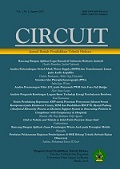POTENSI LASER (light amplification by stimulated emission of radiation) SEBAGAI PENDETEKSI BAKTERI (Studi awal detektor makanan halal)
DOI:
https://doi.org/10.22373/crc.v3i1.3638Abstract
Penelitian untuk mengetahui keberadaan mikroorganisme pada sebuah benda merupakan kebutuhan yang sangat penting dilakukan. Bakteri Escericia coli sebagai mikroorganisme patogen banyak ditemukan didalam feses hewan. Penggunaan laser untuk mendeteksi keberadaan bakteri memberikan hasil yang cukup signifikan. Dengan panjang gelombang 532 nm dan 650 nm spektrum spekel bisa ditangkap oleh kamera CMOS 30 fps 12 mp dengan baik, sehingga dihasilkan intensitas kontras yang berbeda. Titik Sampel yang ada bakteri memeiliki nilai kontras yang lebih kecil dibandingkan denghan titik sampel yang tidak ada bakterinya. Pengukuran intensitas dilakukan dengan menggunakan sofware Matlab 7 dengan arah penyinaran Vertikal dan sudut kamera 450
References
Ahmadiah Yusro, 2016. Optimasi laser dioda 405 nm untuk penonaktifan biofilm bakteri staphylococus epidermidis. Skripsi, Fisika FST UIN Maulana Malik Ibrahim .Malang.
Harmadi, 2011, Aplikasi Pola Spekel Akusto-Optik untuk Pendeteksian Vibrasi Akustik pada Dental Plaque Biofilm, Disertasi, PPs Universitas Airlangga, Surabaya.
Meli. Dkk, 2013, Analisis pola dan ukuran bulir spekel menggunakan LSI pada lapisan tipis TiO2, jurnal fisika dan aplikasinya, volume 9 no 2.
Pelczar, J. M. dan Chan, E. C. S. 1998.Dasar-dasar Mikrobiologi.UI-Press, Jakarta.
Periassami, 2009. Optical probe in biology. CRC press. New York
Photonic spectra, 2017. The bandwith bottleneck. Laurin Publishing, Sunnyvale.
Shulika oleksiy, 2009. Advanced lasers (laser physics and technology for aplied and fundamental science). Springer. USA
Silvia Galikano, CNN Indonesia | Rabu, 25/05/2016 09:54 WIB
Tippler, P.A. 1991. Fisika Untuk Sains dan Teknik. Erlangga . Jakarta.
Thomas h lee, 2009. The design of CMOS radio frequency integrated circuit. Cambridge
www.hyperphisics.com
Published
Issue
Section
License
Authors who publish in CIRCUIT: Jurnal Ilmiah Pendidikan Teknik Elektro agree to the following terms:
- Authors retain copyright and grant the journal right of first publication with the work licensed under a Creative Commons Attribution-ShareAlike 4.0 International License (CC BY-SA 4.0) that allows others to share and adapt the work with an acknowledgement of the authorship and initial publication in this journal
- Authors are able to enter into separate, additional contractual arrangements for the non-exclusive distribution of the journal's published version of the work (e.g., post it to an institutional repository or publish it in a book), with an acknowledgment of its initial publication in this journal.
- Authors are permitted and encouraged to post their work online (e.g., in institutional repositories or on their website) prior to and during the submission process, as it can lead to productive exchanges, as well as earlier and greater citation of published work. (See The Effect of Open Acces)

